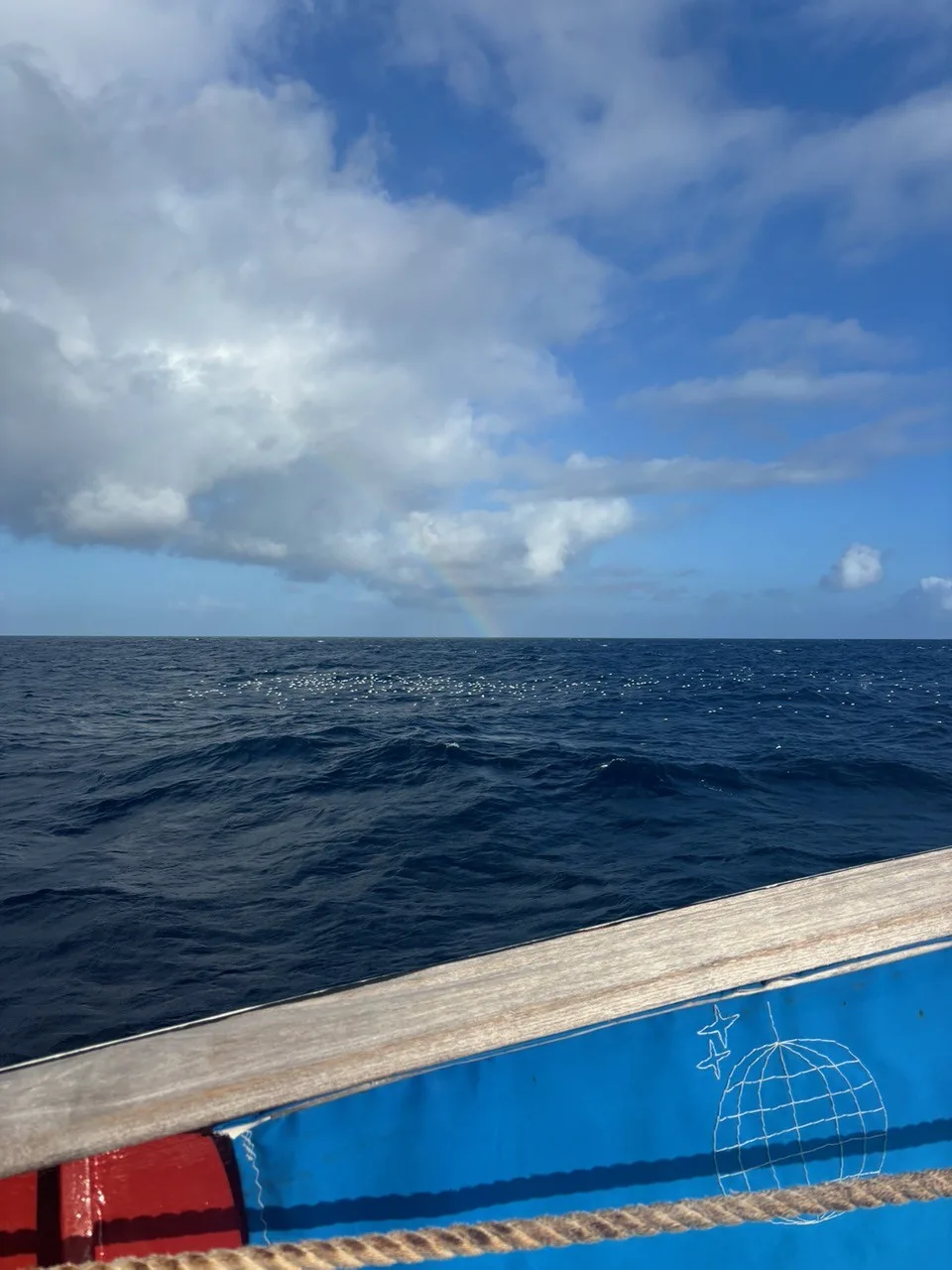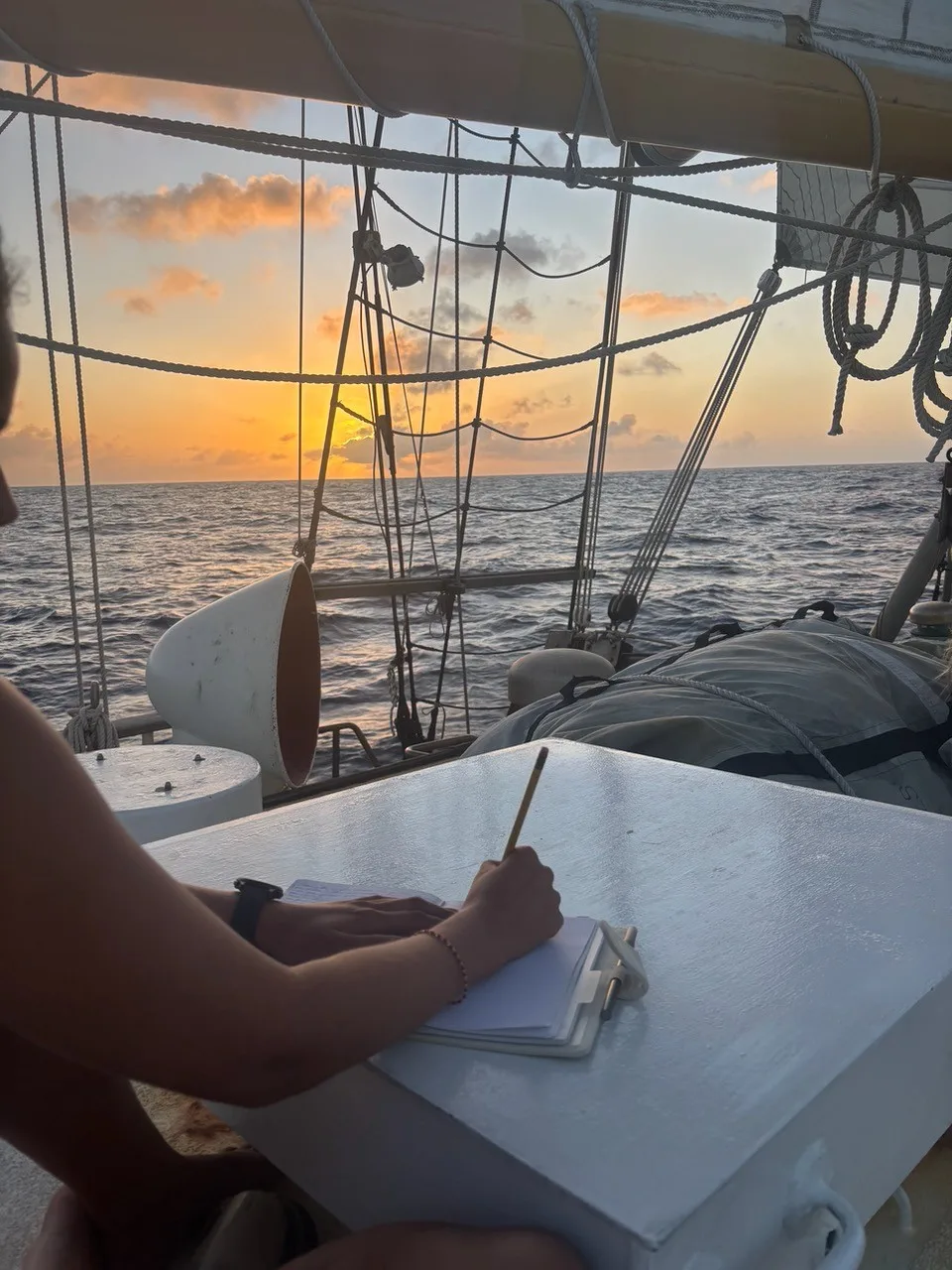Programs Blog
Crossing Zero

June 29, 2025
Time: 0811
Location: Equator!
Weather: Light clouds, beautiful sunset
Hello all!
By pure luck and sheer willpower, I somehow signed up for the blog on the day we crossed the equator TWO weeks ago when I also wrote the first blog of this trip. This affords me the unique privilege to write about one of the more special moments of our journey. In another twist of fate, I had my two-watch day today, beginning with dawn watch and ending with evening watch (0100-0600/1900-0100), hence my writing this the next morning. In our obsession with the equator, and crossing zero, we did so not once, not twice, but three times, the two latter during a fantastically glimmery evening watch. I call it glimmery because there was barely a cloud in the sky, so the Milky Way and all the celestial sphere was visible in full splendor, and while on lookout, I could gaze over the bow into the water, watching as we disturbed millions of bioluminescent organisms, marking our forward path with shining ripples.
You may ask, or you may not care – why was the water so glittery last night? Well, because the equator is one of the most productive regions in the Pacific open ocean, due to the upwelling caused by Easterly trade winds pushing apart the surface waters by a fun process called Ekman transport. What you need to know is that there is much more nutrient concentration, and we got to benefit, running a science station with a towed net through that zero-degree line. The amount of life bouncing out of the surface water and eventually pulled into the net was astounding. The myctophids were finger-sized when they have been toe-sized previously, squid and flying fish were visible off the science deck, and birds were hunting in our lights even in the dead of night.
But let me bring you back to that zero-degree latitude line, our equator. As you should have read in the previous blogs as an avid follower of our adventures, we got to see the green flash at sunrise on my previous dawn watch a few days ago. What is even more special than that is the thin red line that marks the exact position of the equator, visible only in the most perfect conditions. These conditions are so rare, and the line so elusive, that in fact, one must practically imagine it for it to appear. Sadly, nobody saw it on any of the times we crossed. I guess we will never know if it is truly there. We celebrated the crossing all together at 1825 with frozen hot chocolate and frozen coffee. A foreboding message from King Neptune about the smell of our ship also prompted a field day to make sure we were cleared for passage.
I think it is important for me to mention the tradition for a sailor when passing the equator. When you do cross the line on a boat, you go from being a pollywog to a shellback (shoutout Shellback Alley – you will never have enough fan power to reach my bunk). A shellback on this ship is going to be represented by the appearance of one’s head after being shaved. If you are worried about your family member, friend, or partner on this trip participating in the aforementioned tradition, fear not! Let me tell you that if they are losing hair, it is to my scissors and skill. For a long time, I have ventured in the amateur hairstyling world, and what I can promise is that these results are not as bad as you may think. Despite the wind and my limited resources, I persevere. Clients so far have been incredibly satisfied with their results, with more to come today.
I would like to take these final few sentences to express my gratitude, especially towards my parents who helped me get to this place. Even when I am doing the most monotonous of tasks to keep the boat in order, I am so overjoyed to be here because I am on a sailing ship in the middle of the Pacific Ocean, surrounded by the best people and making beautiful memories. I am so happy out here and hope that I can share that joy when I eventually (and begrudgingly) take the flight back home.
Please give Flora and Piper all my love! I hope they remember I exist.
Peace and love,
Emmy Tublin, B Watch
UNC Wilmington


Recent Posts from the Ships
- Ocean Classroom 2024-A collaborative high school program with Proctor Academy
- Collaborations and Long-term Commitments: SEA’s Caribbean Reef Program Sets a Course for Coastal Programs that Compliment Shipboard Experiences.
- Sea Education Association students prepare for life underway using state of the art nautical simulation from Wartsila Corporation.
- SEA Writer 2022, Magazines From the Summer SEA Quest Students
- Technology@SEA: Upgrades Allow Insight into Ocean Depths
Programs
- Gap Year
- Ocean Exploration
- High School
- Science at SEA
- SEA Expedition
- SEAScape
- Pre-College
- Proctor Ocean Classroom
- Protecting the Phoenix Islands
- SPICE
- Stanford@SEA
- Undergraduate
- Climate and Society
- Climate Change and Coastal Resilience
- Coral Reef Conservation
- Marine Biodiversity and Conservation
- MBL
- Ocean Exploration: Plastics
- Ocean Policy: Marine Protected Areas
- Oceans and Climate
- Pacific Reef Expedition
- The Global Ocean: Hawai'i
- The Global Ocean: New Zealand